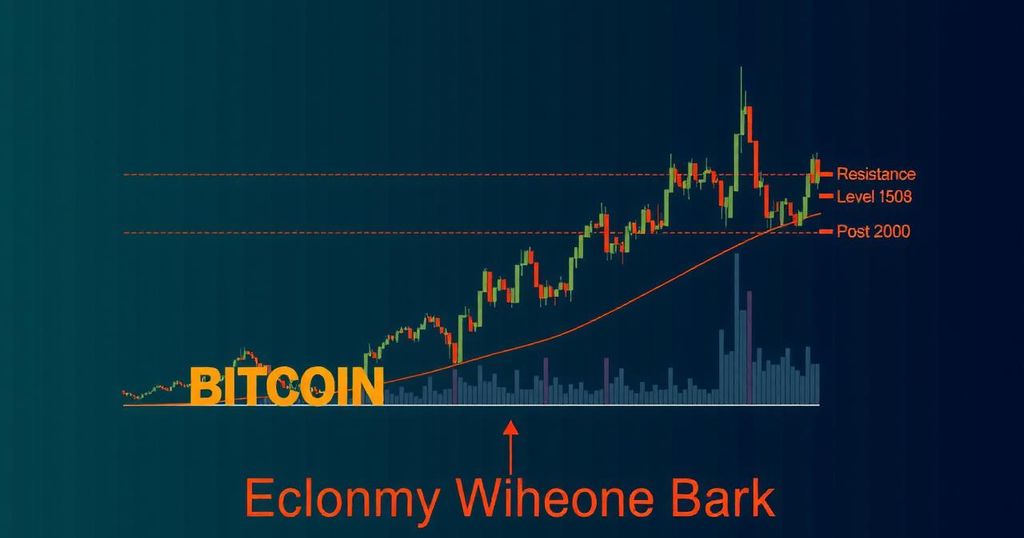Bitcoin’s Outlook: Key Resistance Amid Expectations of Fed Rate Cuts
The prospect of forthcoming interest rate cuts by the Federal Reserve has rekindled interest in Bitcoin and other high-risk assets. Historically, Bitcoin has thrived in low-interest-rate settings, where heightened liquidity channels investments into riskier, high-reward markets. Recent trends in the cryptocurrency market indicate it may be poised for significant movements should these anticipated rate cuts materialize.
The latest minutes from the Federal Open Market Committee (FOMC) meeting suggest that a policy easing could be on the horizon, contingent upon favorable economic data. This indicates a potential shift towards lower interest rates, which would be advantageous for risk assets like Bitcoin. Evidence from past movements illustrates how Bitcoin has historically gained during periods of low interest rates. For example, during the onset of the COVID-19 pandemic in March 2020, as interest rates were lowered, Bitcoin experienced a considerable surge. Conversely, when interest rates rose in March 2022, Bitcoin prices suffered. At this juncture, heightened volatility within the Bitcoin market suggests significant uncertainty; a reduction in US interest rates could initiate another price rally.
Investor sentiment, particularly regarding Bitcoin, appears to be gaining traction. Data from Coinglass indicates that inflows into US spot Bitcoin ETFs have increased over recent weeks, suggesting enduring confidence among investors. Such minor inflows may appear limited compared to total ETF reserves, but they signal an escalating interest in Bitcoin within conventional financial markets.
The remarks delivered by Federal Reserve Chair Jerome Powell reinforced the likelihood of an interest rate cut, subsequently propelling Bitcoin’s price to just under $65,000—the highest level recorded since early August. Notably, this upturn was not confined to Bitcoin alone; other cryptocurrencies such as Ethereum, Solana, and Avalanche also saw impressive gains, showcasing a collective optimism within the digital asset landscape.
An additional signaling factor is the recent rise in stablecoin market capitalization, which hit a record $165 billion. An increasing stablecoin market cap typically suggests fresh capital influx into the crypto space, adding liquidity that may further elevate prices. The interplay between a growing stablecoin supply and Bitcoin’s price movements posits that investors are bracing for an extended bullish phase, influenced by the anticipated interest rate reductions from the Federal Reserve.
From a technical standpoint, Bitcoin currently displays marked volatility, with two ascending broadening wedges identified on the daily chart. The first wedge extends from the November 2022 low of $15,480.68 towards record highs, while the second emerges from the November 2023 low of $34.8k. These wedges intersect at the notable price level of $73.8k, expected for March 2024, serving as a junction for Bitcoin’s price movements.
Recent price consolidation within broad ranges has seen Bitcoin dip to $49.2k, tracing the boundaries of the blue-dotted ascending wedge. Currently, Bitcoin is trending towards the resistance line denoted by this blue trend line, which is pivotal for potential new highs. Should Bitcoin manage to break above $73k, it may facilitate a further upward trend. Alternatively, slipping beneath $49.2k could result in a decline towards $38k.
As the market aligns around the possibility of Federal interest rate cuts, several inherent risks loom. The anticipated cuts are far from guaranteed and are dependent on economic data meeting specific projections. If unexpected economic improvements or inflationary pressures arise, the Federal Reserve may defer or reassess rate reductions. Such uncertainty could induce volatility in Bitcoin’s price as the market may have already incorporated the expectation of these cuts. A failure to meet these expectations could lead to abrupt sell-offs across Bitcoin and other risk assets.
Moreover, Bitcoin’s price movements are intricately tied to broader economic trends; negative shifts in global financial markets could adversely impact its value. Factors such as geopolitical tensions, unforeseen macroeconomic events, or regulatory alterations could dampen investor enthusiasm for riskier investments, including cryptocurrencies. The observed high volatility in the Bitcoin market indicates that even slight departures from anticipated outcomes may result in pronounced price variances.
Investors must remain cognizant of the associated technical risks, as delineated by current price patterns. A failure to surpass the $73k resistance level, or a breach below the $49.2k mark, may prompt further downside movements, testing recent lows and potentially initiating deeper corrections towards $38k.
In conclusion, the prospect of interest rate cuts from the Federal Reserve evokes a sense of optimism within the Bitcoin market, as reduced rates are likely to enhance liquidity and stimulate investment in higher-risk assets. Historical evidence and prevailing investor behavior suggest that Bitcoin stands to benefit significantly from a low-interest-rate environment, potentially resulting in notable price increases. However, with ongoing market volatility, price trajectories remain sensitive to overarching economic conditions and technical indicators.
As Bitcoin approaches critical resistance levels, investors are advised to diligently monitor economic developments and market trends to adeptly navigate potential opportunities and risks. A successful breach above the $73k threshold will open avenues for increased prices, while a drop below $49.2k may heighten the risk of a downturn towards the lower edge of the ascending broadening wedge formation.








Post Comment